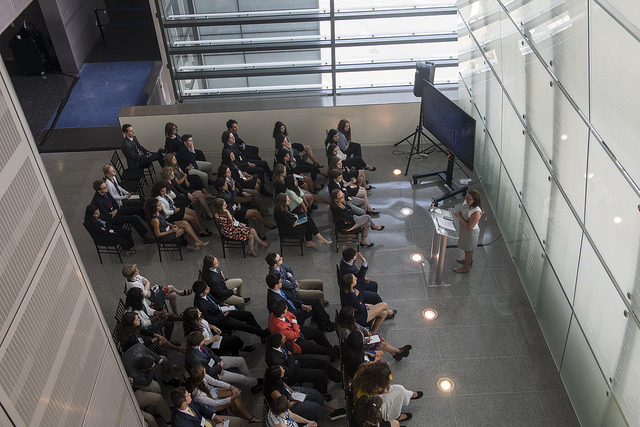Aspiring Journalist Reflects On Dangers of Reporting

Conference attendees sit in the Newseum’s Fallen Journalists Memorial. Courtesy of Freedom Forum Institute.
by Anika Mittu ’19
The truth came to student journalists from across America in the form of 2,232 names etched into glass and a wall of haunting headshots that towered far above our heads.
First, I noticed the demeanor of my fellow free spirits changed instantly. Composed of 51 student journalists from across the country chosen to participate in the 5-day Al Neuharth Free Spirit and Journalism Conference, our group of young writers had originally bonded within hours. We were now on day four of cracking jokes about commas, asking seemingly nonstop questions, and seeing ourselves in the fiery eyes of like-minded peers. And yet, as we each took our seats in the Newseum’s Journalists Memorial, our laughter disappeared.
The space, illuminated by ceiling-high windows, took on an odd silence. And this is where the names etched in glass hung in front of us and the wall of headshots to our left stared down upon us. For the past several days, we had embraced our identities as student journalists. We carried a notepad in one hand and a pen in the other. We sat at the edge of our seats, ready to capture the stories and wisdom that the seasoned journalists who spoke to us in conference sessions had to spare. But we hadn’t yet recognized as a group that journalists—the ones that carry around the same notepads that we do—face a grim reality.
Courtney Radsch, the advocacy director for the Committee to Protect Journalists, approached the podium and greeted our solemn faces. While she elaborated on how journalists face varying levels of rights to free speech and honored those who had risked their lives in order to report the truth, I blinked away several tears. And I noticed some of my peers do the same.
I’m still not entirely sure if I felt more anger or fear at that moment. Anger for the journalists who had already fallen prey to senseless violence and acts committed by those who view journalists as a threat to their own goals and views. Or, fear that me—or one my newfound friends—could one day face the same fate.
We didn’t yet know about Jamal Khashoggi, the Saudi Arabian journalist who was killed by his own government for publicly disagreeing with his prince of his country. We didn’t yet know about Musa Abdul Kareem, a Libyan journalist who was tortured and found dead with 13 bullet wounds.
These horrors are certainly not exclusive to places that Americans can deem far-away and distant. The Capital Gazette Massacre of August 2018 involved the murder of five local journalists in Annapolis. I remember receiving texts from the friends I made at this conference, as we checked in on one another to talk about how the shootings impacted our mental states. The reality that that could be any one of us in a few years settled in. And I felt my heart clench and break for the newsroom located fewer than 40 miles from my high school.
Under an administration that constantly characterizes journalists as an enemy to the people, I fully understand that now is not the time to back away from the freedom of expression that I spent a week celebrating in June at the conference. I sincerely hope that the American people will refuse to listen to the messages that journalists symbolize evil. Or, the walls of names and faces found in the fallen journalists’ memorial will grow soundlessly, stealing from the next generation of journalists that once enthusiastically held a notepad in one hand and a pen in the other.